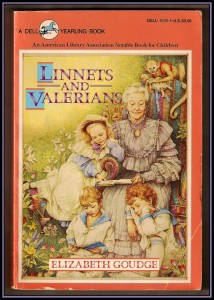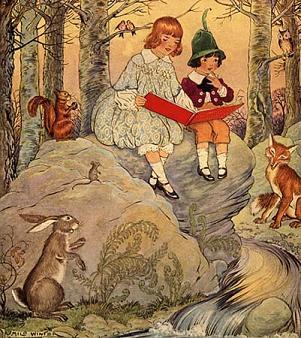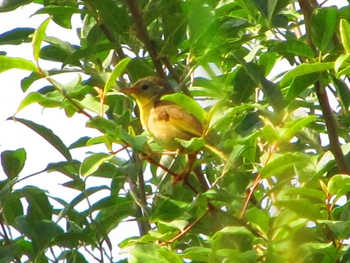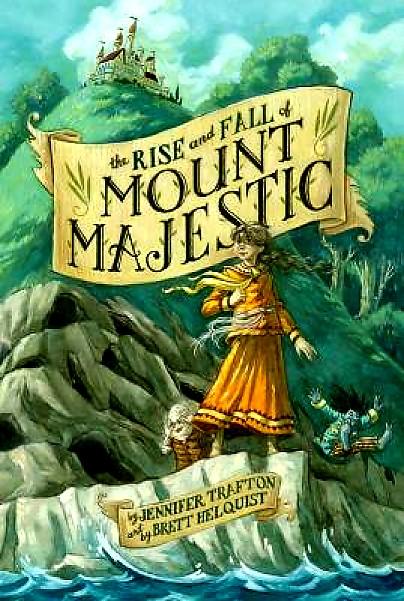Linnets and Valerians (Revised)
 I started reading this novel to my daughters last week, and I raved about it. I’m withdrawing my rave. In fact, I’m discontinuing it as a read-aloud. Normally I don’t write about either unfinished or abandoned books. But since I foolishly wrote about this one before I finished it and would feel bad if anyone else picked it up based on my premature enthusiasm, I feel the need for a second post.
I started reading this novel to my daughters last week, and I raved about it. I’m withdrawing my rave. In fact, I’m discontinuing it as a read-aloud. Normally I don’t write about either unfinished or abandoned books. But since I foolishly wrote about this one before I finished it and would feel bad if anyone else picked it up based on my premature enthusiasm, I feel the need for a second post.
The opening chapters have the Elizabeth Goudge trademark of wonderful place descriptions, as well as entertaining and lovable characters and a goodly dose of humor. A bit farther in, however, it became apparent that in order to read this aloud to my children, I would need to be prepared to talk about witchcraft, voodoo dolls, so-called white magic, and the interweaving of folklore and myth with fact in a way that’s misleading and confusing. I decided to pause the reading aloud and finish it myself before going any further, then realized it would be a mistake to continue it together.
Goudge is classed as a Christian author and comes from a religious family, but Christianity is depicted as colorless, stuffy, incomprehensible and powerless in contrast to the beauty and vitality of nature and its attendant spirits. One of the main characters is a vicar, but even he, along with his servant and the children in his charge, entertain a mysterious faith in honeybees, to whom they pray for protection. (Honest.) The happy ending is brought about not by God’s help (he is never appealed to) but by counteracting black magic with white magic.
What’s the difference between a book like this and, say, the Narnia chronicles, or the Oz books, or The Hobbit, or Alice’s Adventures in Wonderland, or Stardust? There are many fantasies that don’t bother me. One difference is that they have boundary lines between fact and fantastic: a wardrobe, a tornado that takes your house far away, a totally imagined universe like Middle Earth, a rabbit hole or a village wall that defines and limits the realm of alternative reality. This book has no such boundaries. It seems to purport that Pan really walks in Devonshire, that honeybees really are angelic protectors, that superstition is more deeply real than the church of England.
In a separate class is the kind of witchcraft practiced by Emma Cobley in this story, which is of course real. It belongs to the tradition of King Saul in the Bible when he consults the witch of Endor, or Simon the Sorcerer in the New Testament. It’s not defeated with “white magic” but by the Spirit of God. Goudge’s handling of these themes is not what we’re justified to expect from a professing Christian writer.
C.S. Lewis felt that part of literature’s job is to re-enchant the world, and that was what initially attracted me to Elizabeth Goudge. She evokes so effectively the non-physical aspects of a place, evoking a sense of its history and offering exact and detailed observation. It seemed at first to help me remember my own delight in the world, a delight too easily overshadowed by the more prosaic concerns of adult life. But in the end her spiritual vision corrupts my original feeling of kinship. I think I suspected this when I read The Bird in the Tree, then moreso when I read her autobiography, The Joy of the Snow. But somehow I kept hoping I was wrong.
It’s tough to find an author who seems wonderful — only to discover, a few books later, that you have large and serious differences. I still like The Scent of Water and The Dean’s Watch. But my first impressions have significantly cooled as my reading list has lengthened. In fact, this may be it for me.



9 Comments
Mouseprints
Don’t you hate it when that happens? Thanks for coming back and reporting your new findings.
Carrie, Reading to Know
I was expecting to pull this post up and hear your further “rave” thoughts! =D I’m so glad though that you came back and retracted because if I had seen it, I would have picked it up!
As you know, I’m thinking through the use of magic in books and so I appreciated hearing your thoughts. I’ll pop your thoughts in my head and continue to process.
Janet
You might find it interesting that JK Rowling says Goudge’s ‘The Little White Horse’ was her favorite story as a child. :-)
Carol in Oregon
“But in the end her spiritual vision corrupts my original feeling of kinship.”
That says it all, Janet.
Amy @ Hope Is the Word
Hmmmm. Well, maybe this isn’t one I want to read with my girls. Thanks for the addendum to your original review!
Janet
I thought about going ahead and using it as an opportunity to talk about some things, but the vision is just so mixed up. And I think they would need to be a little older.
Also, my husband felt that it would be a mistake to read any more of it. He doesn’t often weigh in on reading choices, so that helped.
Barbara H.
I agree with your differences between fantasy and actual witchcraft.
I’ve had that happen, too, when what seemed a wonderful set of books or author turned out to be unwholesome. Very disappointing.
JW
Good to know. I was going to look up some of her books and start reading. Now instead I will move on to other things more worthy.
Pingback: